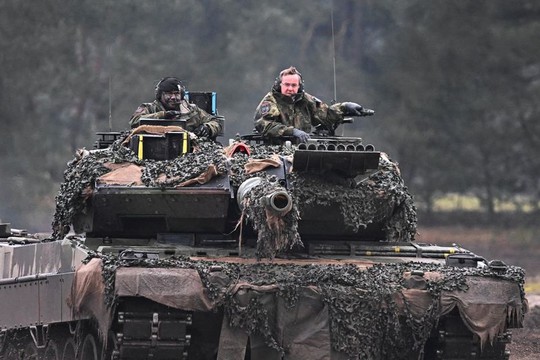German Defense Minister Boris Pistorius, right, rides a tank following the country’s commitment to supply the vehicles to Ukraine.
Photo: Reuters
For months, Germany withstood international pressure to allow neighbors to supply Ukraine with German-made tanks. Yet since Berlin finally yielded last month, only one country in Europe has agreed to dispatch a sizeable contingent, informs “The Wall Street Journal”.
European allies’ reluctance to make good on earlier signals despite intense lobbying from Berlin in recent days is raising doubt that enough tanks can arrive in Ukraine in time for an expected Russian offensive.
It is also leaving Germany’s government in an awkward position it has sought to avoid: becoming the sole purveyor of a large contingent of Western-made main battle tanks for Ukraine. Since the start of the war, German Chancellor Olaf Scholz has made a point of coordinating weapon deliveries with allies.
Europe’s sudden misgivings about supplying Ukraine with tanks reveal that, as with ammunition and heavy artillery, North Atlantic Treaty Organization members in the region have fewer operational tanks that they can spare at a time of heightened geopolitical tension than was originally estimated by experts and officials.
“The fact that there are so few operational battle tanks and that they are so incompatible with each other should be taken as an alarm signal in Europe,” said Nico Lange, a former senior defense official in the German government and now a senior fellow at the Munich Security Conference.
Ukraine had nearly 2,000 tanks.
Britain and France, which have the biggest armed forces among European NATO allies, have around 220 tanks each, but it is unclear how many are actually battle-ready, according to ‘Global Firepower’, an online database.
Germany has a similar number of tanks, with government surveys showing that less than half of them can be deployed because the rest are in need of repair.
So far, only Germany and Poland have approved substantial deliveries of tanks for Kyiv—around 200 and 74, respectively, including a mixture of new and older models. Canada has committed four modern German-made tanks.
The U.S. did pledge to supply 31 of its Abrams tanks but U.S. officials now say it might take up to two years before they arrive on the battlefield.
Britain has committed 14 of its Challenger 2 tanks and said they would be delivered by the end of next month, while France is set to send AMX-10 RC armored-fighting vehicles, which move on wheels rather than tracks but are often considered light tanks because of their heavy firepower.
Netherlands and Denmark committed to help finance the purchase of around 100 decommissioned Leopard 1 tanks that are now owned by German companies Rheinmetall AG and FFG mbH. The Leopard 1 was decommissioned in Germany two decades ago but private firms and other governments still own an undisclosed number of the older tanks.
Under the agreement, the Netherlands, Denmark and Germany will jointly finance the refurbishment of the tanks and provide training for Ukrainian crews.
France has ruled out sending any of its just over 200 main battle tanks, known as Leclercs, with officials citing technical and logistical difficulties.
Portuguese Prime Minister Antonio Costa told parliament on Thursday that his country was carrying out maintenance on Leopard 2 tanks and would deliver three vehicles in March.
Among the other countries that initially signaled they might send tanks to Ukraine if Germany allowed it are Finland, Sweden, Belgium and Spain. Those countries haven’t so far made any commitment, although officials from some of them have said they would work together with allies on training and financing.
A spokesman for the Belgian government said the country had no tanks to give.
Most European countries “either don’t have enough tanks to start with — Denmark has only 44 Leopard-2 tanks and the Netherlands has 18 that it leases from Germany,” said Ms. Alander, “or have limitations due to own needs, as in the case of Finland with its long border with Russia.”
By contrast, Russia started the war with over 12,000 tanks.
read more in our Telegram-channel https://t.me/The_International_Affairs

 10:10 16.02.2023 •
10:10 16.02.2023 •























